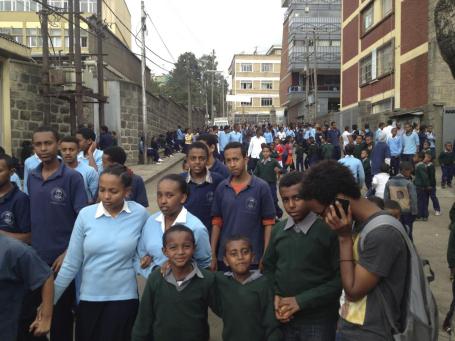Film: “Enlarging the Kingdom: African Pentecostals in Europe,” available at http://www.pentecostalaesthetics.net/documentary
Last week, we watched the short ethnographic film, “Enlarging the Kingdom: African Pentecostals in Europe.”1 In the past, when I’ve watched ethnographic films as part of a class, I’d noticed that students sometimes are sometimes tempted to just sit back and watch the film as it goes by. For whatever reason, it’s been my experience that students are sometimes less prepared to watch films critically than they are to read books with the same kind of inquisitive attitude. To counteract this tendency and encourage my students to sit up and ask questions as they were watching the film, I put together a question worksheet for them to fill out after I turned down the lights.2 I used the questions on the worksheet to prompt us when the discussion slowed down or one of the lines of our conversation reached an end.
Part of our conversation was about immigrant communities’ feelings about education. Charismatic/Pentecostal Christian movements are among the fastest growing Christian communities around the world. During the unit about the Charismatic Catholic Renewal, I wanted my students to see how Charismatic/Pentecostal Christianity is shaping Catholicism from within. “Enlarging the Kingdom” is an example of how these movements are shaping Catholicism from without. I invited my students to compare the Ghanaian Charismatic/Pentecostal leaders’ statements about Charismatic/Pentecostal schools in Italy to Italian community leaders’ comments about public schools in Harlem, as reported in Robert Orsi’s The Madonna of 115th Street. Although my students grasped the differences in these sentiments, I don’t think that I had prepared them to articulate what it is about the role of education in an immigrants’ lives that would lead them to feel this way.
In re-reading The Madonna of 115th Street, sometimes it seems that the Italian immigrants in East Harlem are constantly talking about school. School was perceived as a place where young people went to be “Americanized.” Like many things that were associated with “America,” schooling was an ambivalent experience. It was perceived to be a threat to the family, or domus, which was the locus of meaning for Italian immigrants in East Harlem. Orsi sometimes describes this ambivalence in expository language: “Immigrant parents were not always sure they saw the point of working hard in school, since that might not necessarily result in the security of the domus” (111).
The comments Ghanaian Charismatic/Pentecostal leaders offered about their schools in Italy strike a more unabashedly positive tone than these reflections from immigrants in Italian East Harlem. In the film, one minister complains about his church’s difficulty renting spaces from the Italian government, which refuses his community’s applications. Italians have been reluctant to join his church, he says, because his parishioners can only afford a small and squat space, compared to the large Cathedrals Italians are used to worshipping in. Schools are one area in which his community has had success. “We have a school called the Meus Christian School; it is a Deeper Life [church] school, registered with the Italian government.” He trumpets the school’s success, noting that young people are graduating as “well-oriented” and “responsible” adults who “can make a contribution to society.”
My students were able to convey the gist of these contrasting views about school in response to my question that asked them for expository information: How do Ghanaian immigrants feel about their experience in Charismatic/Pentecostal schools? How do Italian immigrants feel about their experience in New York City public schools?
What was less successful was my question that prompted students to reflect on the role of education in personal and social formation. When I asked students why people go to school, they offered comments about education as a way for people to “advance,” “develop themselves,” and “start a career.” I was struck by these relatively uncritical appraisals of the role of education in social and personal formation, but I think I got these responses primarily because I had phrased my question in such general terms. Also, students are the ones currently benefitting from the educational system. Even if they might feel ambivalent about school, as many first-generation college students do, I don’t think I have succeeded in creating an environment in my classroom where my students can talk about this experience openly. I would have liked to have had my students talk about how education also forms people in a more fundamental, embodied manner. Why is it that people feel comfortable sitting in rows, in desks, writing on laptops and in notebooks? If going to school helps them feel comfortable doing these things, what kinds of activities are they not comfortable doing, whether this is a direct result of going to school or not?
We were able to talk about “formation” in this sense when we read Rebecca Lester’s book about “religious formation” in a Mexican convent. I was struck that week when one of my students talked about how formation is like “changing your personality” – an apt analogy. In retrospect, I might have phrased my question about schooling in these terms, since this is how my students seemed to understand what happens in “formation.” I might have asked, “How does going to school change your personality?” I’m not sure this would have helped my students grasp the intricacies of this process, either. Still, I feel helping students understand the underlying purposes of religious education is important.
- 1Available online at http://www.pentecostalaesthetics.net/documentary
- 2I’ve included the worksheet here.
